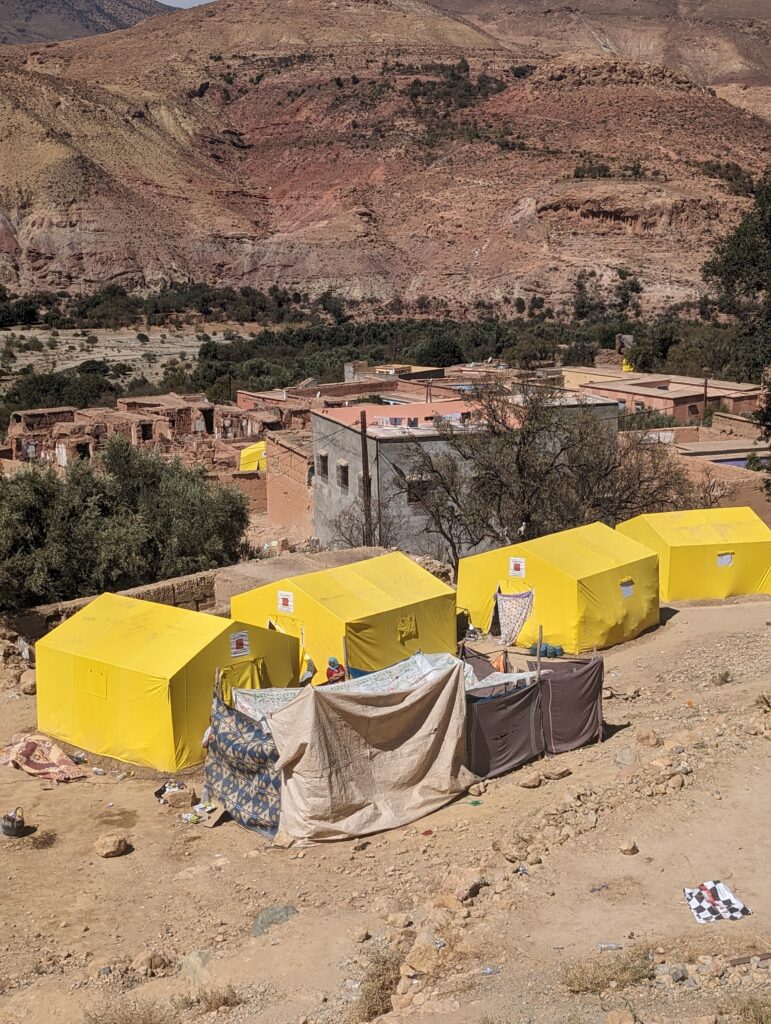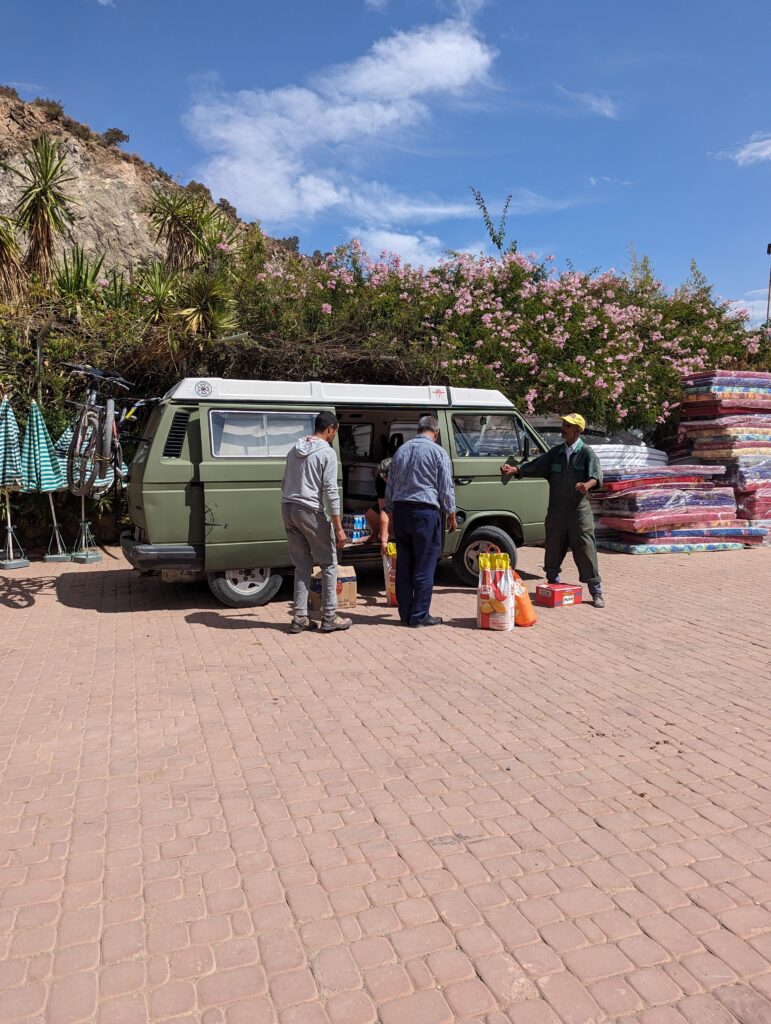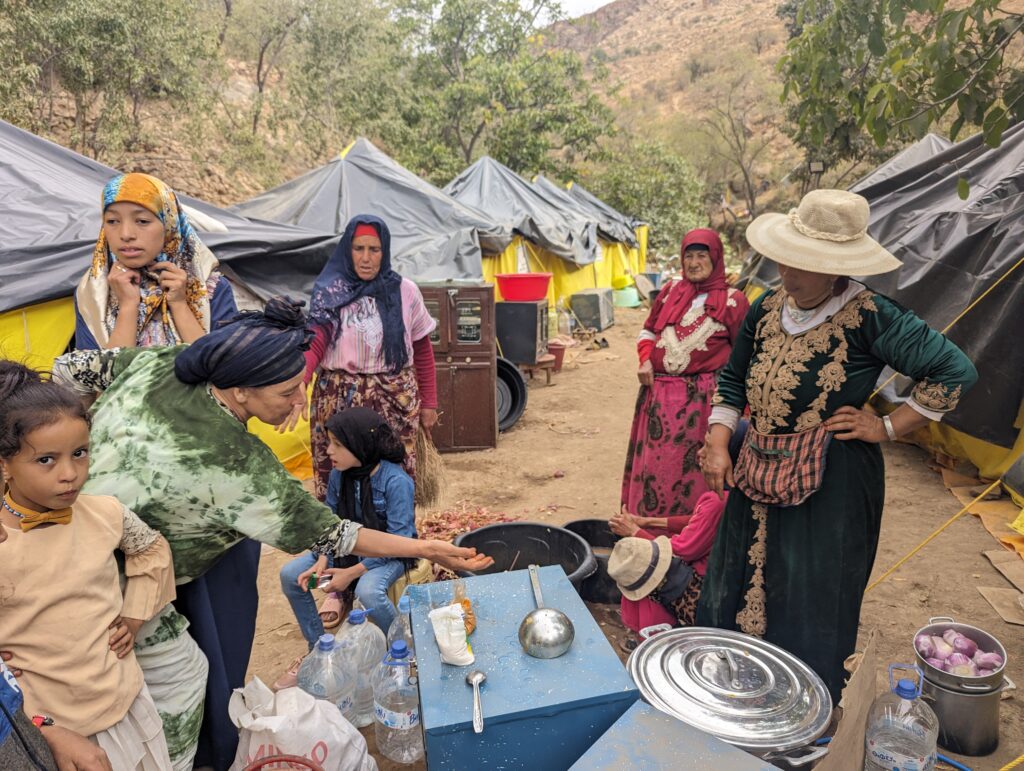I Was There For the Morocco Earthquake. This is What it Was Like.

Emily Draper is our Patchie Correspondent who has joined our team to write about her experiences travelling the world as a woman. Emily is an accomplished writer who has visited 80 countries. She had been in Morocco for several months before the quake happened. You can read more about her experiences by clicking here.
On the 8th of September at 11:09 pm, five friends and I sat down at a sea-view rooftop restaurant in Imsouane, Morocco – rumour had it they served the best crepes in town. Usually, the time I arrived at a restaurant several weeks ago would be insignificant and long forgotten by now, but on this occasion, there’s no way I could forget.
Two minutes later, at 11:11 pm, as I was talking with friends about the promising prospects of tomorrow’s surf, the town fell silent. The electricity had stopped working.
But the silence didn’t last long. As I peered into the blackened town, a loud rumble seemed to creep towards me and suddenly, I was violently shaken in my seat. Before I even had a chance to process what was happening, my friend grabbed me by the arm and said in an alarmingly stern tone “We need to get out of here. Now.”
So we ran. We ran as fast as we could down three rickety flights of wooden stairs even though the ground was barely catching my feet with each step. I don’t know how I made it down and out into the street but I do remember thinking the ceiling might collapse on me before I did. Luckily, my friends and I all made it out of the building safely and as the rumbling stopped I looked around me to find the street filled with people, their eyes just as wide as mine. None of us knew it then, but what we had just experienced was Morocco’s most powerful earthquake in over 100 years.
Over the next hours, we lay sleepless in the streets in fear of buildings collapsing on us and frantically searched online for answers about the earthquake. We found its epicentre was pinpointed to a small village in the High Atlas Mountains called Imindounit, located 112 km southwest of Marrakesh and where a Patch Adventures was scheduled to be in just a couple of months time.
Measuring as a 6.8 magnitude earthquake on the Richter Scale, we knew its impact was going to be devastating and that we were lucky to have been spared from its wrath. By the next morning, the now-named Al Haouz earthquake had hit international headline news.
The next few days went by in a time-warped daze as the picture of the earthquake’s devastation became clearer. Videos of people narrowly escaping crumbling buildings circulated online as news agencies posted live updates on the death toll. I couldn’t help but watch, knowing that as I ran to safety during the earthquake, there were so many people who couldn’t.

The earthquake rippled out from deep within the High Atlas Mountains to Marrakech and beyond. However, the mountains absorbed most of the earthquake’s potential energy and so its small village communities were impacted most heavily. Entire villages had instantly crumbled to the ground and trapped their villagers in the rubble, many of whom never got out alive.

Although the earthquake response was fast, it took rescuers days to reach many of these villages. Many were built in the mountainsides and valleys along one single road from Marrakech which had been blocked in dozens of spots from landslides. Before authorities could even begin to help with the survival efforts and deliver aid, they had to first confront the monstrous task of just clearing the roads. Sadly, this meant that some villages went up to a week without any medical help or aid relief. There was nothing to eat, nowhere to take shelter, and nobody to free their families’ dead bodies from the rubble.

It felt heavy to know that the earthquake had so drastically altered the lives of so many people in the Atlas Mountains without warning. As much as I wanted to help, Morocco’s problems seemed so big and I felt so small and helpless. However, it was clear to see that the earthquake victims needed any help they could get no matter how small.
So, my friend and I went to a supermarket and bought as much food and water as we could fit into his VW T3 and tootled as quickly as the old thing would carry us towards Ouirigane where they were distributing aid. We were greeted warmly on arrival by local volunteers who quickly helped us unload the van and add it to the mountains of food, blankets, water bottles, and bags of flour that had been delivered by other locals hoping to do their part. Seeing the amount of aid contributed by individuals gave me such a sense of pride and empowerment from the people of Morocco.

After delivering the aid, I decided to continue further toward the epicentre to report on the earthquake’s aftermath. I was prepared to see some sad and even disturbing sights as I got closer but nothing could have prepared me for the heart-crushing stories I would hear about that fateful night. A 24-year-old woman named Fatima Ihihi said “My husband was away so I grabbed both of my children (9 months and 2 years) and jumped out of the house. There was a huge crack in the road in front of me and within three seconds of escaping, my house crashed down behind me”.
Others weren’t so lucky. A 13-year-old girl who was due to start her first year at Adasil College in hopes of one day becoming a teacher said “I lost my mother and sister in the earthquake and I am scared because I feel unsafe…like I could die at any moment too”. The girl and her father were two of just seven survivors of Tikht, a village previously populated by 75 people.
Tikht is just one of dozens of villages that were almost entirely flattened by the earthquake. But the homes, schools, and businesses that have been destroyed were clearly nothing compared to the destruction it caused to people’s lives. The High Atlas villagers will never return to their family homes, see their loved ones, or feel safe in a building again.

But in amongst the anguish and torment in the High Atlas communities was also a widely shared gratitude for their life and a strengthened community bond that will allow them to carry each other with kindness into the uncertain future.
As of now, the earthquake’s victims have been given tents as temporary shelter and they have a steady supply of food and medicine. What they need next is for their villages to be quickly rebuilt as they face a cold, harsh winter ahead. One of the best ways we can ensure this happens, aside from making donations to organisations and charities like MBLA Morocco is to continue supporting the region with tourism.

The Atlas Mountains is a loved travel destination by many where you can hike North Africa’s highest mountain, swim in a tropical oasis, zip your way through the desert on a dune buggy, and star gaze under the clear night sky. The sense of adventure it evokes is only beaten by the sense of awe you feel when wandering within its belly. While parts of the mountain have been temporarily broken, the Moroccan’s spirit hasn’t been. They continue to lead exciting Atlas Mountain tours and share the beauty the region beholds despite its recent scars.
What’s it like in the Atlas Mountains now?
At the time of writing, it has been exactly one month since the Al Haouz earthquake rocked Morocco. Having been here throughout this time, I can assure future visitors that the country’s travel and tourism began running as normal again (even in the Altas Mountains) only one week after the earthquake occurred. There is no need to cancel or rearrange your exciting trip! The risk of aftershocks or a second earthquake has subsided, so rest assured that you will be safe. As I mentioned, tourism is one of the best ways people can support this worthy country because the economic impact of lost tourism could be just as great as the earthquake itself.
Right now, Patch Adventures is kicking off a tour in Morocco. We never considered cancelling, because we know that doing so just adds even more misery to the pile.